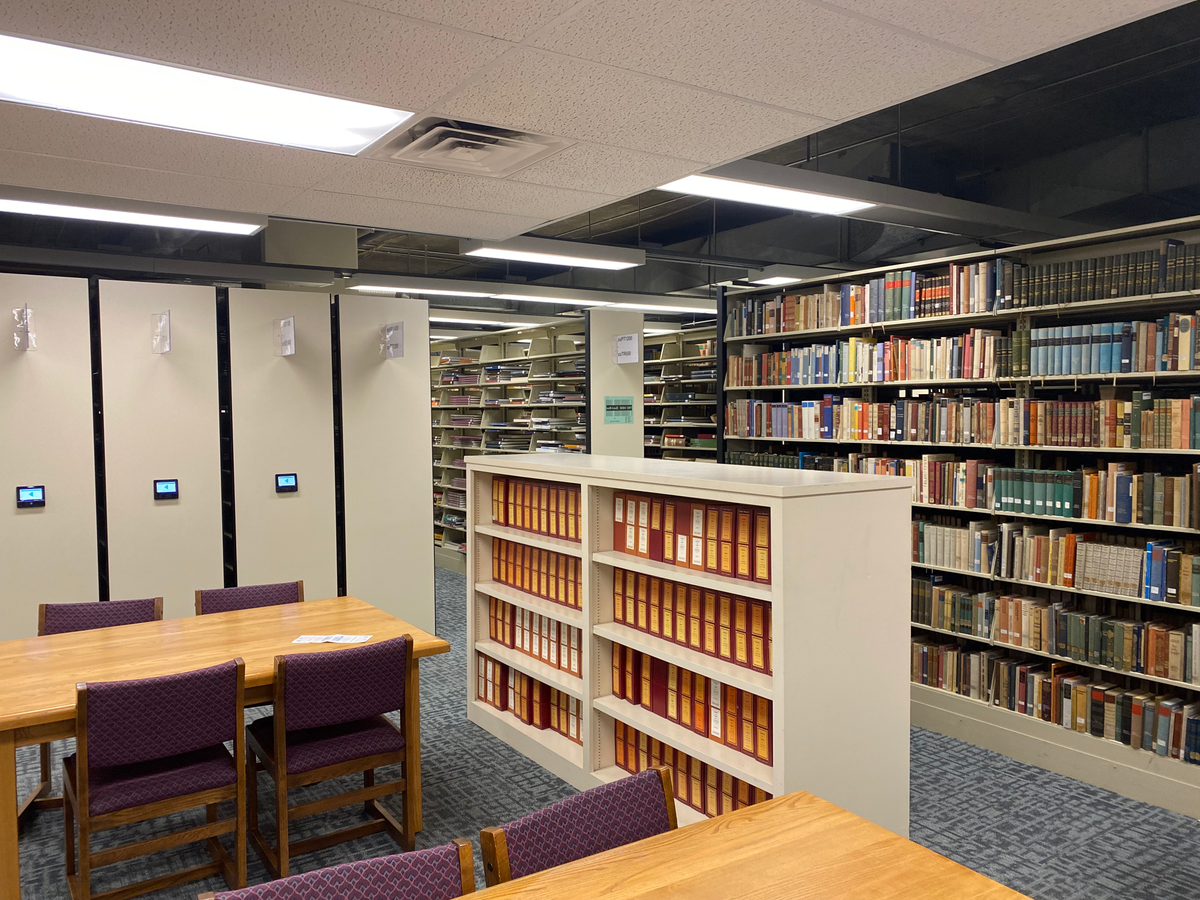Three Stories Down: Reflections From the Catacombs
Senior Managing Editor Liam Archacki ’24 shares a piece he wrote during one of his long study sessions in the bottom level of Frost, which makes the case for C-level as, improbably, the best place to work on campus.

When I think of the most solitary place on the Amherst campus, I think of the Catacombs. For the uninitiated, “the Catacombs” is the macabre name bestowed upon Frost basement’s deepest level. It’s home to many, many books — and a select handful of dauntless studiers.
The space itself is a maze of poorly lit book shelving. The wall nearest to the front entrance and those perpendicular to the shelves are plastered brick, pock-marked by age. The back wall, bone-white, features many tiny perforations, presumably for some insulatory purpose. I find them concerningly reminiscent of the breathing holes one pokes into the temporary home of a birthday-gifted shih tzu.
The ceiling of the room (perhaps glimpsed with your head thrown back in despair) is a scuffed gray. Just below it lies an exposed grid of ventilation passages, pipes, and wires, which at least suggests the Catacombs has little to hide.
With its pattern of varicolored lines, the design of the carpeting echoes the maze motif of the shelving. Luckily, the abundance of well-placed “exit” signs assuage any fears of becoming hopelessly lost amid the literary labyrinth.
I don’t mean to give the impression that the Catacombs are completely inhospitable. Some kind soul thought to line the front wall with wooden cubicle desks and pepper the outskirts of the labyrinth with a few group-work desks. This might even make you think that person-to-person connection occurs here.
But in the Catacombs, silence is the highest law. The only sounds heard are the dull hum of the air conditioning and the occasional beeps which signal the shelves’ movement as they collapse together to open up one row and close another. A series of laminated yellow signs cautions, “Check for people between shelves.” One can only wonder what grave incident preceded their addition, and whether the unlucky party dared break the one law — or simply accepted their fate.
Time is a concept with which the Catacombs are unconcerned. No clock chimes out on the hour. The room sits deep enough in the Earth to prevent the infiltration of any of the sun's rays. And several black-and-white photos of the Amherst campus — the only sanctioned visual art in the room — secure the space’s sense of timelessness.
The morbid moniker “the Catacombs” may strike some as over-exaggerated — the room is just underground, after all. But it seems more apt when you consider the primary inhabitants of the space: the books themselves. As the walls of the actual French Catacombs are lined with the bones of several million long-dead Parisians, our Catacombs serve as the sepulchral home for the life’s work of not quite as many authors. A wasteland of ideas only occasionally scavenged by the intrepid researcher.
Now the kicker: This bleak, foreboding, downright creepy graveyard of thought is my preferred study spot on the Amherst campus.
The way I see it, there’s something perfectly fitting about doing your coursework in such an unnatural environment. For a brief spell, you can remove yourself from the technicolor social world of pleasant chatter and wide smiles, and escape into the Catacombs — where other people don’t exist, time is inconsequential, and the only voice to be heard is the one inside your head. The gruel of essay writing or problem-set solving makes the most sense to me in this sort of individual unreality.
And sometimes a little isolation or a little silence is simply what you need.
But while I’m frequently the only living body in the Catacombs on a Sunday night — excluding the Sunday directly before finals week — I never feel entirely alone. The cubicle desks, my preferred haunts, are home to numerous messages and drawings, which have been, one can only imagine, etched in extreme boredom by decades of Amherst students.
These include the encouraging (“U got this!”), the poetic (“The wood are lovely, dark and deep…”), the illustrative (including an intricate rendering of a tree, courtesy of the Amherst Botany Club), the profound (“WE ARE ALL POT SMOKERS”), and, too frequently, the pessimistic (“You can’t do it”).
And sometimes, down in the Catacombs, this is the concern that interrupts my solitary page-flipping. Can I do it? Can anyone do it?
To the right of the cynic’s scribble, some later commentator has appended the word “Alone.”
To that, another says, “bet,” and one more still, “PREACH!”
While isolation allows us to focus on our work, or partake in a healthy amount of introspection, it’s our relationships with others, even the faceless shadows of the Catacombs, that ultimately assure us of the worth of our efforts.
So my stay in the Catacombs must always come to an end. I place the final touches on my assignment, collect my things, and head for the heavy metal door. As I ascend the winding staircase to the world of the living, I’m sure not to look back — I’m confident that my wits and my sanity trail just behind.




Comments ()